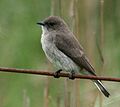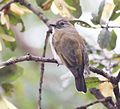This article needs additional citations for verification .(December 2009) |
| Honeybirds | |
|---|---|
 | |
| Wahlberg's honeyguide Prodotiscus regulus | |
| Scientific classification | |
| Kingdom: | Animalia |
| Phylum: | Chordata |
| Class: | Aves |
| Order: | Piciformes |
| Family: | Indicatoridae |
| Genus: | Prodotiscus Sundevall, 1850 |
| Type species | |
| Prodotiscus regulus [1] Sundevall, 1850 | |
| Species | |
Prodotiscus regulus Contents | |
Honeybirds are birds in the genus Prodotiscus of the honeyguide family. They are confined to sub-Saharan Africa.
References - Honeybird - A guide by J Ian L. Gong










